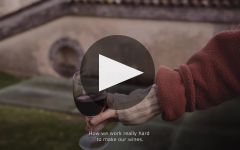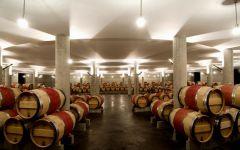Chateau L'Evangile 2017
-
Wine
Spectator -
Jeb
Dunnuck -
James
Suckling -
Wine
Enthusiast - Decanter
-
Robert
Parker



Product Details
Your Rating
Somm Note
Winemaker Notes
Professional Ratings
-
Wine Spectator
This is a breed apart, with a remarkably dense yet lithe core of braised fig, warmed plum sauce and steeped black currant fruit, coated with ganache and melted licorice details and infused with incense and black tea notes. Incredibly lush through the finish, but maintains cut and drive due to the well-embedded alder spine. Best from 2022 through 2040.
-
Jeb Dunnuck
Production was down 40% at Chateau L’Evangile due to the frost. The 2017 Chateau L'Evangile is 100% Merlot, and 2017 is the first time this cuvee has not included some other variety. Aged 16 months in 75% new barrels, it's a ripe, powerful L'Evangile loaded with chocolate-laced black fruits, mocha, toasted spice, and subtle oak. These carry over to the palate, where the wine is medium to full-bodied, has plenty of oomph and power, yet stays flawlessly balanced and even elegant. It’s a stunning example from the vintage that’s going to benefit from 4-6 years of bottle age and cruise for two decades.
-
James Suckling
The generosity in this wine is essence-like with black cherries, black truffles and wet earth. Full-bodied and deep with rich, creamy tannins and a long, intense finish. It goes on for minutes. Silky and fantastic. Extremely well done. Drink after 2023.
-
Wine Enthusiast
This dense wine is packed with intense tannins. The secret to the wine, which is 100% Merlot, is not just the structure but the immensely ripe black-plum and -berry fruits that envelope the dry core, lending opulence and richness. The wine has a lift of freshness on the finish. It will age, and should not be opened before 2024.
Barrel Sample: 93-95 -
Decanter
This has a lovely silkiness to it, one of the real successes in the appellation in terms of the texture and the quality of the tannins. It's a fairly powerful 100% Merlot with 100% new oak - an unusual combination because the old vine Cabernet Franc was lost to frost in 2017. This is one of the few wines that gets close to the quality of 2016, even if it's not quite there in terms of its completeness. 30 days maceration at reasonable temperatures has brought out the heart of plump blackberry fruit, while delivering subtle tobacco and slate elegance. I like this a lot. 100% organic in the vineyard (2016 was 95% organic) but not certified. 60% grand vin this year, from 40hl/ha.
Barrel Sample -
Robert Parker's Wine Advocate
All of the Cabernet Franc was frosted in 2017, so L'Evangile is composed of 100% Merlot for the first time. Deep garnet-purple colored, the 2017 L'Evangile is a little closed to begin, offering glimpses at blueberry preserves, baked plums and black raspberries scents before revealing nuances of spice cake, cinnamon stick, dusty soil and garrigue plus a waft of incense. Medium to full-bodied, the palate has a lot of richness and depth, with firm, ripe, rounded tannins and just enough freshness, finishing long and spicy.
Other Vintages
2022-
Robert
Parker -
James
Suckling -
Jeb
Dunnuck - Decanter
-
James
Suckling -
Robert
Parker -
Jeb
Dunnuck
-
James
Suckling -
Wine
Spectator - Decanter
-
Jeb
Dunnuck -
Robert
Parker -
Wine
Enthusiast
-
Jeb
Dunnuck - Decanter
-
Wine
Spectator -
James
Suckling -
Robert
Parker
-
James
Suckling -
Robert
Parker - Decanter
-
Jeb
Dunnuck -
Wine
Enthusiast
-
James
Suckling -
Jeb
Dunnuck - Decanter
-
Robert
Parker -
Wine
Spectator -
Wine
Enthusiast
-
James
Suckling -
Jeb
Dunnuck -
Robert
Parker -
Wine
Spectator -
Wine
Enthusiast - Decanter
-
Robert
Parker -
James
Suckling -
Wine
Enthusiast -
Jeb
Dunnuck -
Wine
Spectator - Decanter
-
Wine
Spectator -
Wine
Enthusiast -
James
Suckling
-
Wine
Spectator -
James
Suckling -
Robert
Parker
-
Robert
Parker -
Wine
Spectator -
James
Suckling
-
Robert
Parker -
Wilfred
Wong -
Wine
Spectator
-
Robert
Parker -
Wine
Spectator
-
Robert
Parker -
Wine
Enthusiast -
Wine
Spectator
-
Wine
Spectator -
Robert
Parker
-
Wine &
Spirits
-
Robert
Parker
-
Wine
Spectator -
Robert
Parker
-
Robert
Parker -
Wine
Spectator
-
Robert
Parker
-
Wine
Spectator -
Robert
Parker
-
Robert
Parker
-
Wine
Spectator -
Robert
Parker
-
Wine
Spectator





The property was known as “Fazilleau” until the mid 18th century, and soon after, became famous under its present denomination “Chateau L’Evangile”. The 35 acres vineyard is grouped around the Chateau on clay-based gravel. By one of those curious mysteries of Bordeaux soil, a long strip of gravel appears in the middle of the Pomerol Plateau, mixing with the local clay. The wines of this soil have been well known since the poet Ausonius sang their praise. The vines, on average, are 30 years old. Indeed Blason de L’Evangile, the second label of Chateau L’Evangile, is selected from vats of the “Grand Vin” Chateau L’Evangile, it features characteristics similar to those of the “Grand Vin”, but with lesser potential for ageing as its ageing in barrels is much shorter. Its name comes from the former owners who used their emblem. It must be drunk younger than its more robust counterpart. The Léglise family from Libourne founded the property that was to become Chateau L’Évangile. They were actively involved, around the middle of the 18th century, in the creation of Pomerol’s vineyards. L’Évangile appeared in the 1741 land registry under the name of Fazilleau.
At the turn of the 19th century, the estate was already close to its current configuration, stretching over some 13 hectares, when it was sold to a lawyer named Isambert. He renamed the estate “L’Évangile”. In 1862, L’Évangile was purchased by Paul Chaperon, whose descendants, the Ducasse family, remained the property’s owners until 1990. Paul Chaperon continued to build the estate’s reputation and constructed L’Évangile’s residence in the style of the Second Empire. In the second edition of Cocks Féret in 1868, L’Évangile is listed as a “Premier Cru du Haut-Pomerol”.
Upon the death of Paul Chaperon in 1900, his descendants ran the estate until 1957, when Louis Ducasse took over the property, which was by then in decline and had been damaged by the frost in 1956. He managed to replant the vineyard and eventually restored L’Évangile to its former glory. In 1982, his widow, Simone Ducasse, continued the family’s role in running the estate.
In 1990, Domaines Barons de Rothschild (Lafite) acquired L’Évangile from the Ducasse family with a view to ensuring that the property was looked after to the same high standard. DBR (Lafite)’s initial influence included a more refined selection of the Grand Vin, and the creation of Blason de L’Évangile as a second wine. Efforts were also undertaken to improve the vineyard with a restoration and partial renewal plan that was launched in 1998. The complete renovation of the vat room and the cellar, which was finished in 2004, completed the property’s new configuration.

One of the world’s most classic and popular styles of red wine, Bordeaux-inspired blends have spread from their homeland in France to nearly every corner of the New World. Typically based on either Cabernet Sauvignon or Merlot and supported by Cabernet Franc, Malbec and Petit Verdot, the best of these are densely hued, fragrant, full of fruit and boast a structure that begs for cellar time. Somm Secret—Blends from Bordeaux are generally earthier compared to those from the New World, which tend to be fruit-dominant.

A source of exceptionally sensual and glamorous red wines, Pomerol is actually a rather small appellation in an unassuming countryside. It sits on a plateau immediately northeast of the city of Libourne on the right bank of the Dordogne River. Pomerol and St-Émilion are the stars of what is referred to as Right Bank Bordeaux: Merlot-dominant red blends completed by various amounts of Cabernet Franc or Cabernet Sauvignon. While Pomerol has no official classification system, its best wines are some of the world’s most sought after.
Historically Pomerol attached itself to the larger and more picturesque neighboring region of St-Émilion until the late 1800s when discerning French consumers began to recognize the quality and distinction of Pomerol on its own. Its popularity spread to northern Europe in the early 1900s.
After some notable vintages of the 1940s, the Pomerol producer, Petrus, began to achieve great international attention and brought widespread recognition to the appellation. Its subsequent distribution by the successful Libourne merchant, Jean-Pierre Mouiex, magnified Pomerol's fame after the Second World War.
Perfect for Merlot, the soils of Pomerol—clay on top of well-drained subsoil—help to create wines capable of displaying an unprecedented concentration of color and flavor.
The best Pomerol wines will be intensely hued, with qualities of fresh wild berries, dried fig or concentrated black plum preserves. Aromas may be of forest floor, sifted cocoa powder, anise, exotic spice or toasted sugar and will have a silky, smooth but intense texture.
